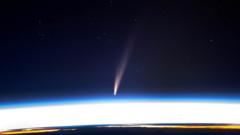A rare celestial phenomenon is set to grace the skies over the next few days as Comet C/2024 G3 (Atlas) approaches its closest point to the Sun, or perihelion. NASA officials have noted that this comet may soon be visible to the naked eye, with predictions suggesting a brightness similar to Venus. This occurrence is extraordinary, as it has not been documented in around 160,000 years.
Dr. Shyam Balaji from King's College London highlighted that current orbital calculations indicate the comet will pass roughly 8.3 million miles from the Sun. These calculations classify C/2024 G3 as a "sun-skirting" comet, adding to its rarity and intrigue. While the exact timing and location for viewing remain uncertain, experts suggest that the best visibility is likely to take place in the southern hemisphere.
Observers are advised to look eastward before sunrise and westward after sunset for potential sightings. Despite anticipated brightness, Dr. Balaji cautioned that comet visibility is often unpredictable, noting that some comets can appear fainter than initially expected. In the northern hemisphere, conditions could prove more challenging due to the comet's proximity to the Sun, which may obstruct views.
For those eager to catch a glimpse of this extraordinary event, seeking a dark location away from city lights and employing binoculars or small telescopes may enhance viewing chances. Caution is urged around dawn and dusk while tracking the comet's position in the sky.
NASA astronaut Don Pettit recently shared a stunning photo of Comet C/2024 G3 captured from the International Space Station, remarking on the awe-inspiring sight of a comet from orbit. As stargazers and astronomy enthusiasts prepare for what could be dubbed the "comet of the century," all eyes will be on the skies in anticipation of this rare spectacle.


















